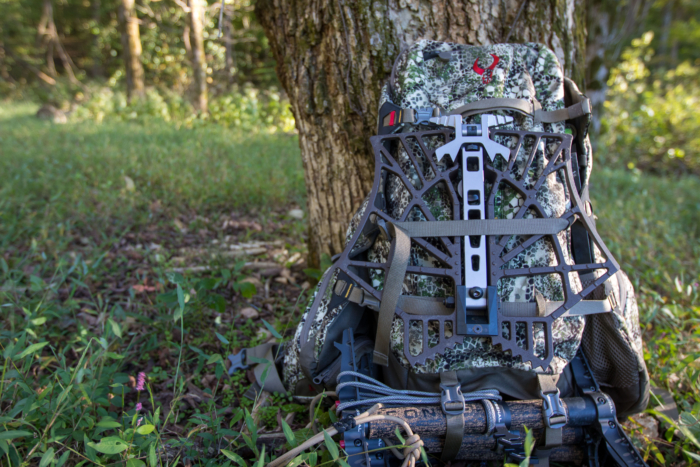It was 8:55 a.m., and I was trying my darndest to get out of the tree as quickly as possible. “Slow is smooth, smooth is fast,” I reminded myself. At the base of the tree, I took off my insulating jacket and bibs, put my climbing sticks together, and placed them in the Badlands 2200 backpack. With the cinch of a few straps, I had all of my gear in a nice, neat, highly mobile package.
Where was I off to in such a rush? Not after deer, if that’s what you’re thinking. I had a 6-year-old’s birthday to attend, and if I didn’t get a move on, I was going to make the family late to “The Lost World: Dinotopia.” Oh, how the mighty have fallen.
I cut it real close, but I made it home with just enough time to fulfill my fatherly duties, and the backpack helped me do it. You see, for weeks I had been hunting with a pack that was borderline too small, and it was really inefficient. By bumping up to a little bit bigger of a pack, I could be in and out of a tree in record time.
In short: Small packs are great for day hunts, but they have to be packed perfectly when you have a lot of gear. That’s easy enough to do the night before a hunt, but in the field, it’s not so simple. You can end up repacking the thing multiple times whenever you need to get into it. Thanks to the Badlands 2200, those days are behind me. The size is a touch bigger than most day packs, but not so big that it’s cumbersome. With a meat shelf and all sorts of organizational features, it is now my go-to for deer hunting.
See how the Badlands 2200 stacks up against the Best Backpacks for Big-Game Hunting of 2025.
-
Allows for good organization -
Great size for day hunts -
Multiple straps -
Excellent suspension system for a pack of this size
-
Too small for most overnight hunts -
Expensive for size -
Water bladder compartment is odd
How Big Does a Whitetail Pack Need to Be?
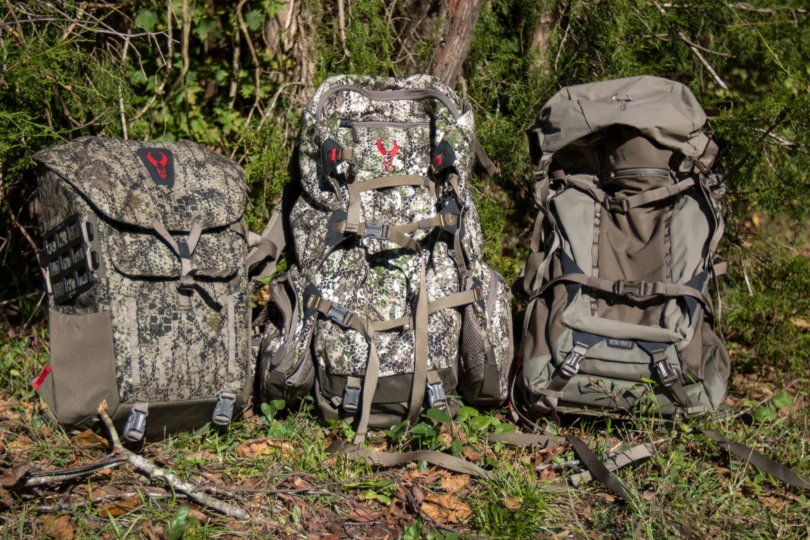


There seems to be an annoying trend in “whitetail” packs: keeping things the size of a standard backpack. For those who hunt farms and private land where you don’t have to walk far to get into your stand, a small pack makes total sense. But 90% of the whitetail hunters I know don’t fit that description.
The vast majority of whitetail hunters I know are public land warriors. They hike in far, looking for hidey holes away from the crowds. Many leave the truck at ridiculous hours of the night, just to use a canoe or kayak to access water-locked parcels.
Long sits are the norm. There are no expensive leases, easy access, or permanent tree stands. Which means you have to carry one.
Being mobile is becoming popular for a reason, and it’s because it pays off to go far. For those situations, a standard-sized backpack just doesn’t cut it. You need to carry everything you might need on your back, which means a mobile pack should be bigger, not smaller.
My Packing List for a Day Hunt
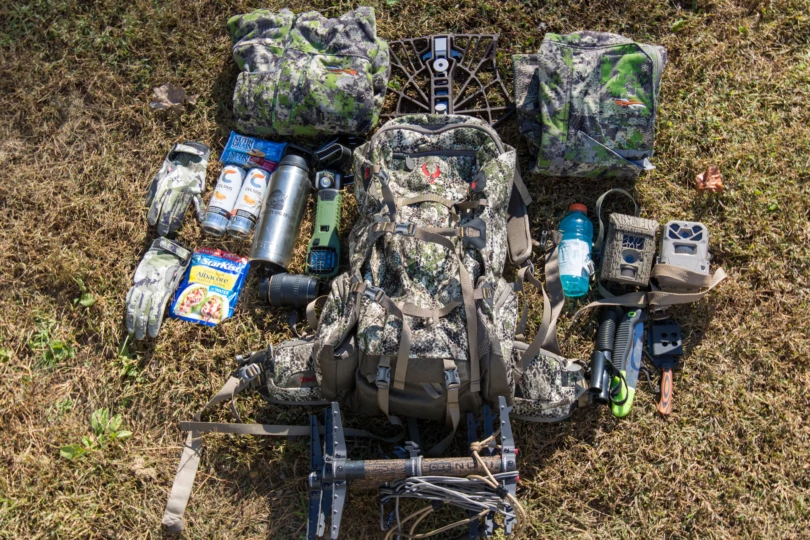



To put it in perspective, here’s the list of everything I pack in my backpack on a day-long whitetail hunt:
- Water bottle (large enough for an entire day)
- Energy drink (probably two)
- Snacks
- Insulating bibs and jacket (I hike into my spots. Wearing insulating layers would cause sweating and leave me cold. I put it on at the tree.)
- DSLR Camera (I have to get photos for my articles somehow)
- Knife
- Limb saw
- Rain gear, if needed
- Headlamp
- Climbing sticks
- Platform for saddle
- Beanie and gloves
- Bow strapped to pack on long hikes
- Trail cameras. Sometimes I’m redeploying them, or picking them up to recharge batteries
I wear my saddle and a midlayer. You see what I’m saying? Good luck stuffing all of that into a 900-cubic-inch pack. I’ve done it, but it gets really, really tight. And you basically have to unpack half of the thing and repack it every time you need to get inside.
Not Too Big, Not Too Small. The Badlands 2200 Is Just Right.
When it comes to backpacks, I follow the mantra: “You can always leave space in a big backpack, but you can’t add more to a small one.”
But let’s be real, I don’t need a backpack capable of a multiday expedition. When I decided to change packs, I realized I needed something in between the too-small day packs and bags designed for western hunting.
Luckily, the Badlands 2200 fits that bill perfectly. With 2,750 cubic inches of packable space, it was a much roomier option, but still compact enough for treestand use.
After one day with it, I was in love. I no longer struggled to fit everything in my bag. In the field, I could quickly toss things into it without worrying about rolling my jacket into a tiny ball or placing everything just right. There were no fighting zippers or straps to get it to close.
It fits everything I need for a day of hunting, with a bit of room to spare. That little bit of extra room will come in handy during the late season, when a thermos of coffee and extra layers get added to the packing list.
In the tree, the extra size is noticeable, but it’s not so big that it’s ridiculous. I could still hang it in front of me and use it as a knee rest while in the saddle.
Straps Galore
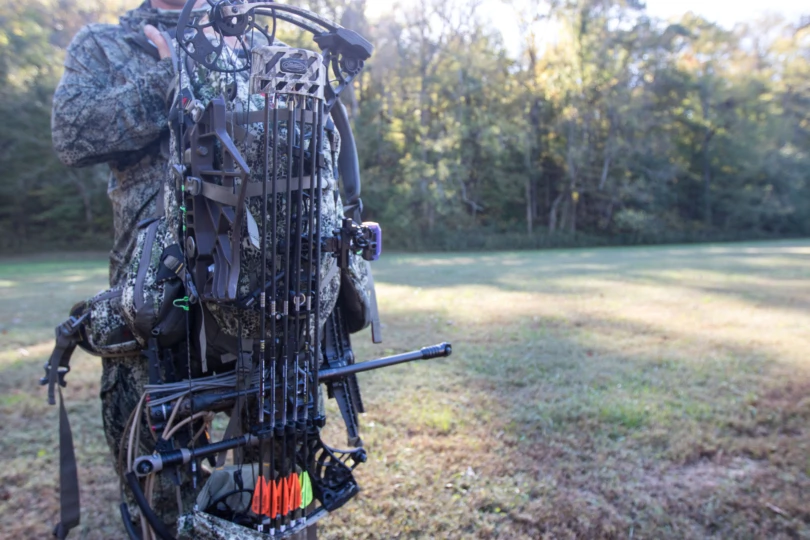



One of my favorite things about the pack is the seemingly limitless strap options. As a whitetail hunter, I like having a bunch of stuff strapped to the outside of my pack because it gives me quick access to things I need. I typically strap my climbing sticks, platform, bow, and occasionally a tripod, to the exterior of my pack.
There are very few packs with enough straps to accommodate that much “junk” on the outside. But this one does. There are two straps on the underside of the pack, which I use to store my climbing sticks. Three straps line the front of the exterior, and are used to strap the tripod, platform, and the bow in.
Seems like a lot for three straps, right? Well, it’s possible, thanks to an ingenious design.
‘Batwing’ Design
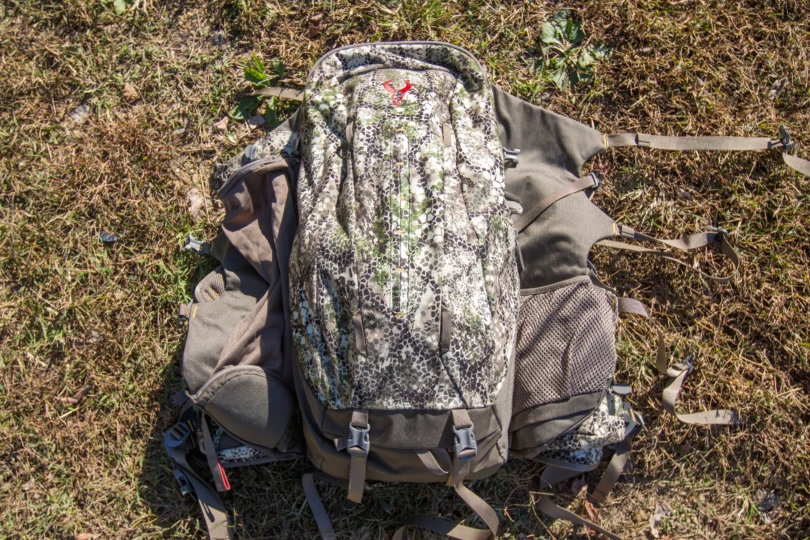



Two fabric “wings” run the entire length of the backpack on each side. Those wings keep loads secured and tight to the center, but also allow for some really cool storage options.
On the left side, there is a stowable spotting scope pocket. To use it, unzip the pouch at the bottom and pull out the fabric tube to store the scope. The batwing will fold over it and buckle into the three straps, keeping it nice and protected. Or, in my case, you can leave the pocket stowed, and thread the straps through a platform, placing it securely to the side of the pack.
On the other side, there’s a mesh pocket at the bottom of the batwing for you to place a tripod. I’ve packed mine in there, and it works great.
The three straps used to close the batwing system can also secure a bow or rifle to the front of the pack. There’s a stowable sling at the bottom of the pack as well, which can be used to support a cam or a butt stock.
When I’m headed into the woods, the batwings on each side keep my platform and tripod secure, while the front straps keep my bow tight to the pack. Everything is at the ready, and the overall system I’m running with it is very efficient.
Frame and Suspension of the Badlands 2200
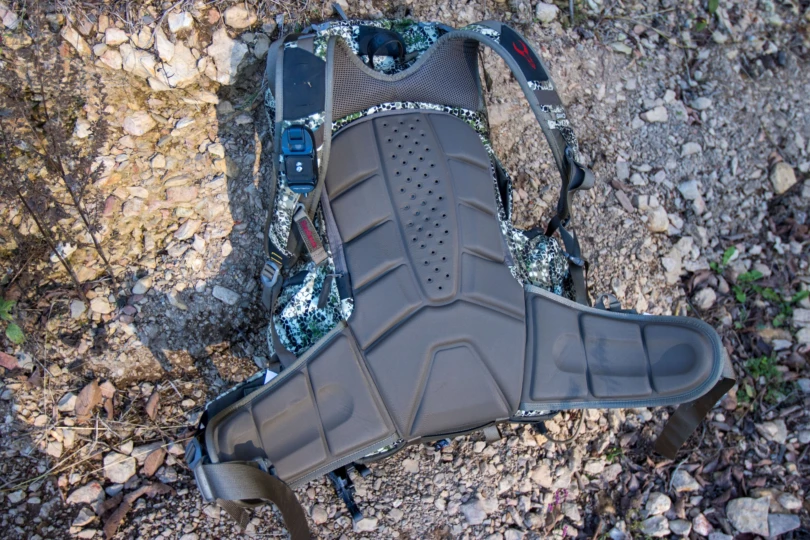



The Badlands 2200 is an internal frame pack. When you unzip the back panel (which makes getting things at the bottom of your pack super easy), you’ll find a Super Magnesium Rod on each side that runs from the top to the bottom. They’re in internal sleeves and provide very rigid support.
The magnesium construction is supposed to reduce weight. However, fully unloaded, the 2200 weighs 5 pounds, 10 ounces, which isn’t all that light, especially considering its size. But still, the frame does its job well, in a small, inconspicuous way.
The overall suspension system is fantastic, and that’s where a significant portion of the $400 price tag comes from. The entire back panel and waist strap are molded foam. The pack has all of the suspension features of a much larger pack, with a solid hip belt, chest strap, and load lifters on each shoulder.
Allegedly, over time, the foam will develop a memory contoured to your body. I haven’t worn the pack enough yet to test it, but based on how the foam feels, I could see that being the case.
Even with a medium-sized load, I can tell just how effective the suspension system is. The pack carries very comfortably, and I can shift the load to my hips with ease.
From going on monthly backpacking trips starting at 8 years old with my dad, to the Army, and big game hunting, I have plenty of experience carrying heavy loads on my back. I can say that while this pack isn’t necessarily the best option for heavy loads, I certainly wouldn’t shy away from one with the 2200. Which takes us to the meat shelf.
Meat Shelf
The Badlands 2200 is more than just the perfect-sized day pack. It’s meant to haul meat.
On the underside of the pack is an integrated cloth meat shelf, which can easily accommodate a deer or elk quarter. You pull it out, put the meat on the exterior, front of the pack, and secure it with the batwing strap system.
Obviously, it’s not as nice as the meat shelf found on Badlands’ larger packs. Those packs store the meat in between the frame and the pack itself, close to your back. That keeps the weight close to you, which reduces fatigue and is much easier to carry. Since this pack pushes it out on the opposite side of the pack, the weight will be more noticeable.
However, given the pack’s size, it would have been nearly impossible to put the shelf in between the frame and the pack. It would need an external frame, which inherently will make the pack larger.
While the placement isn’t ideal, it is a really cool feature that makes this one very versatile pack. It’s not like the placement is going to make a pack job impossible, just a little less comfortable. If you’re in the mountains chasing elk, or in the sage brush hunting muleys, you can pack meat without having to use a bulky backpack all day.
Other Cool Little Features of the Badlands 2200
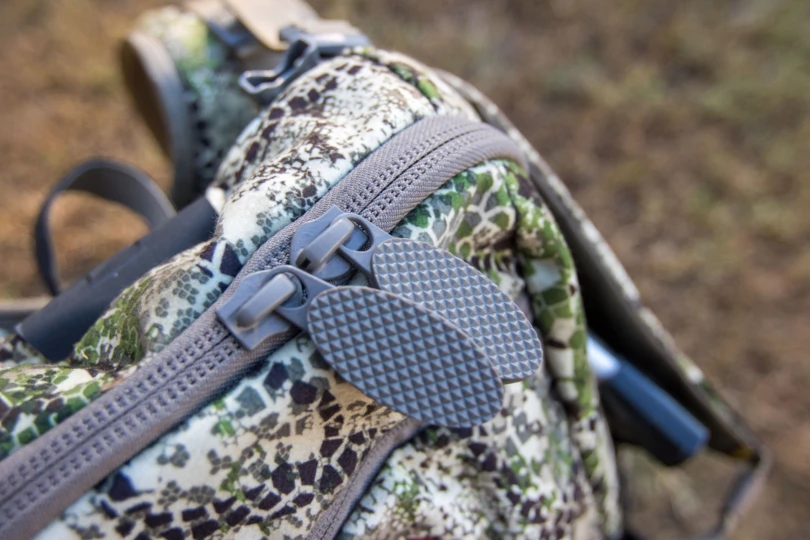



There are lots of handy pockets on the exterior of the Badlands 2200. The best part is that they’re large enough to be functional. Here are some of my favorites.
The two pockets on the hip belt are pretty standard and are nifty for holding a headlamp, knife, and granola bars. But just offset of those are two tall pockets on the side of the pack, and they’re sweet. They provide quite a bit of external storage.
My absolute favorite use of them is as a cupholder while up in the tree stand. I pack my energy drinks in there, and then leave it open while in the stand. No more worrying about them spilling in my pack after opening them.
There is a very deep vertical pocket that runs down the front of the pack. The zipper is very unassuming, and based on that, you’d think it closes a tiny, worthless pocket incapable of storing anything.
But when you open it up and reach in, you’ll realize its ridiculously deep. I haven’t measured it, but it feels at least a foot deep and is very wide. I can stuff a limb saw, snacks, and gloves in there with a bunch of room to spare. It is so nice to have such a large pocket easily accessible on the exterior of the pack.
Another subtle detail I’ve come to appreciate is the very large pull tabs on the zippers. Rather than just a little string tether, there are massive, textured tabs. Oftentimes, the batwing design covers the pull tabs, so having such large ones makes it very easy to locate them when you can’t visibly see them. It also makes opening the pack a breeze while wearing thick gloves.
What Could Be Better
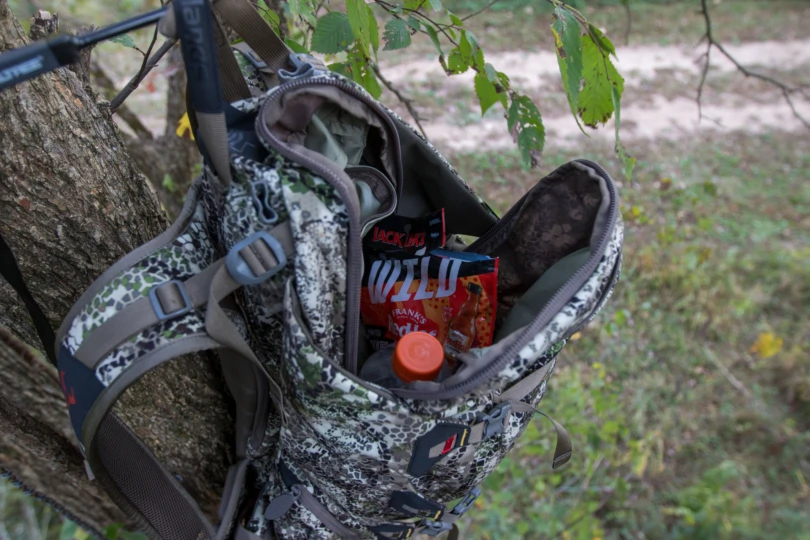



There are very few things that I think would improve this pack. It’s been in the Badlands lineup for a very long time, for very good reason. It’s excellent.
But I will say, the pack is expensive for its size at $400. You can get a lot of pack for that type of money, and that is the main reason the score suffers. On the plus side, it does have arguably the best warranty and return policy of any hunting pack made, so spending the money on it is risk-free.
I do dislike the hydration bladder storage. It’s limited to a 2L bladder, and the bladder storage pocket is short and wide, rather than tall and skinny. That means it only works well with the oddly shaped Badlands 2L hydration bladder. So plan on picking up one of those, too. The random one you have lying around probably doesn’t fit. Hence, the Gatorade bottle in the above picture.
Is the Badlands 2200 Just for Whitetail Hunters?
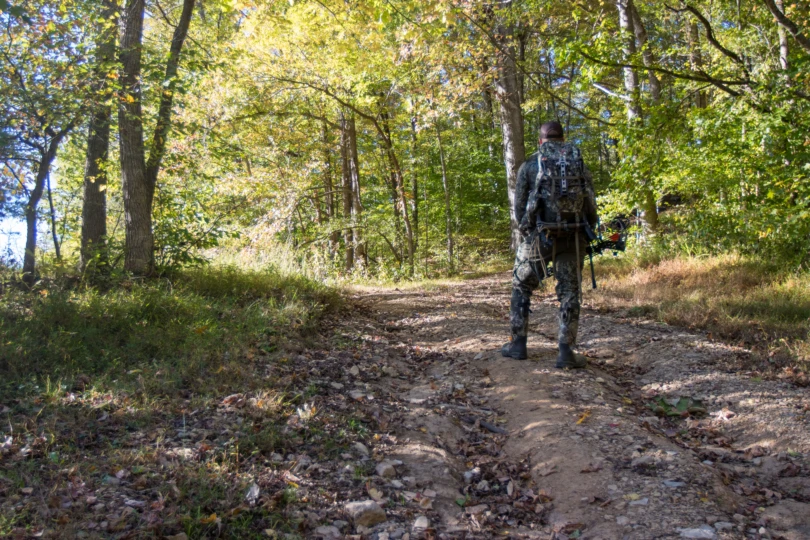



This review has been my thoughts on this pack’s performance as a whitetail hunting pack. It’s excellent at that, but it’s not the designed purpose of the bag, and there are plenty of hunters who should consider it.
Western Hunters
When I lived out West, I was obsessed with backcountry hunting for a number of years. I’m talking about those trips where you go deep into the wilderness for a week at a time with everything on your back. This ain’t the pack for that.
Over the years, I started getting smarter about hunting and hunted where the animals actually were. Yes, that meant going deep into the backcountry sometimes. But other times, after the animals left the high country, it meant a boring car camp was the better bet. And that is where the Badlands 2200 really shines.
I’m going to go as far as saying that this is the perfect day pack for many Western big game hunters, specifically, deer hunters. It has just the right amount of storage without being ridiculously bulky for day missions, and the meat shelf gives you a solution for packing after a successful hunt.
Could you use it for day-long elk missions? Yes, but when packing out huge animals, there are better meat shelves out there. I would still do it with this one, though, even though its not ideal.
Short Overnighters
There are also a few situations where I would use this as an overnight pack. The example that comes to mind is an elk hunt I was on 4 years ago. I was set up in a car camp, only 2 miles from where I was hunting. But it was the most god-awful, horrendous 2 miles you can experience. That’s why the elk were there.
So I resorted to a spike camp. I would load up an ultralight tent, sleeping bag, pad, stove, and enough food for 2 days and camp out on the ridge overlooking the area. When I ran out of provisions, I would take the short (but awful) hike back to the main camp to reload on food.
With all of the exterior straps, the Badlands 2200 would perform just fine in that situation. I can strap a small tent and sleeping pad to the outside, and have room in the main compartment to put a sleeping bag in a compression sack. With optics, stove, food, and layers, its a bit of a tight squeeze, but definitely doable.
Final Thoughts
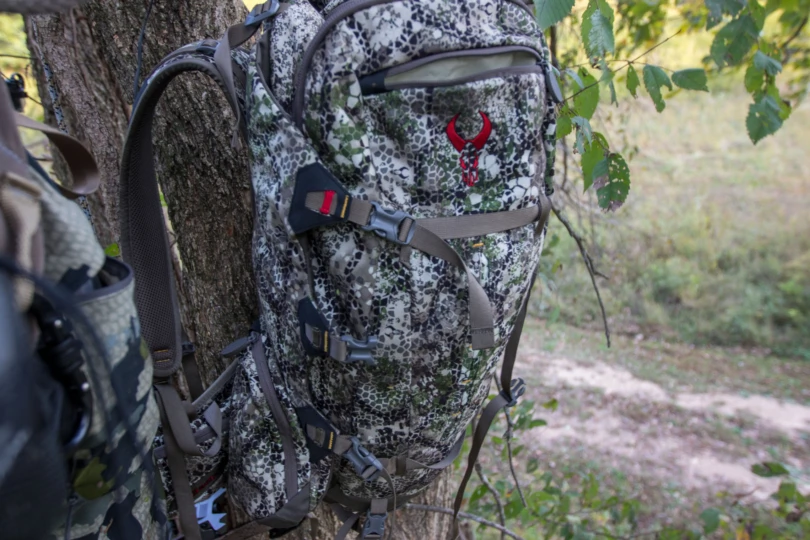



Now that I live in the Southeast and start and end most of my hunts at the truck, the Badlands 2200 has become my go-to backpack. The support system and paneling are fantastic, and the multiple exterior pockets keep me nice and organized in the stand. Everything has its place, and I don’t waste time searching around for things in the field.
While I have yet to use the meatshelf, it is nice to know I have it. Almost all of my big game hunting is focused on whitetail, and I drag my deer out. But I do have an upcoming hunt where I may be hiking pretty far into steep terrain, and quartering may make more sense. If I need to resort to that, the 2200 is ready for it.
Most importantly, the size of this hunting backpack seems tailor-made for my single-day hunts. I’m never left wishing I had more room to stuff one more trail camera in or wishing it was less bulky. The size is so perfect that it’s hard for me to make the change to anything else.
Read the full article here




